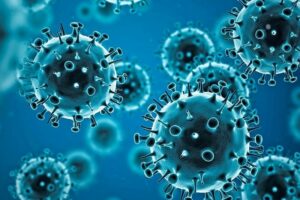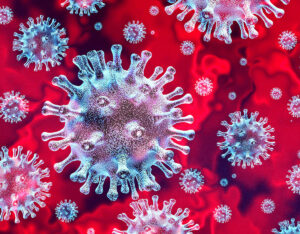Table of Contents
COVID-19 (coronavirus disease 2019) is a disease caused by a virus named SARS-CoV-2 and was discovered in December 2019 in Wuhan, China. It is very contagious and has quickly spread around the world.
COVID-19 most often causes respiratory symptoms that can feel much like a cold, a flu, or pneumonia. COVID-19 may attack more than your lungs and respiratory system. Other parts of your body may also be affected by the disease.
- Most people with COVID-19 have mild symptoms, but some people become severely ill.
- Some people including those with minor or no symptoms may suffer from post-COVID conditions — or “long COVID”.
- Older adults and people who have certain underlying medical conditions are at increased risk of severe illness from COVID-19.
- Hundreds of thousands of people have died from COVID-19 in the United States.
- Vaccines against COVID-19 are safe and effective. Vaccines teach our immune system to fight the virus that causes COVID-19.

Improve your English at home with our Spoken English Course
Paragraph Writing on Covid-19 in 150 Words
Coronavirus, also known as Covid-19, is an infectious disease. It interferes with the human respiratory system, making breathing difficult. It is a contagious illness that is sweeping the globe like wildfire. In Wuhan, China, the virus was first discovered in 2019. Covid-19 was classified as a global pandemic by the WHO in March. Through coughing, sneezing, etc., an infected person was spreading the virus. As a result, everyone avoided the affected individuals. The affected individuals were even kept apart from their own loved ones and family. Patients in Covid – 19 have also reported fatigue, a sore throat, muscle aches, and a loss of taste and smell.
Even their own family members and other loved ones were separated from the affected people. Other issues mentioned by Covid-19 participants included fatigue, a sore throat, muscle stiffness, and a loss of taste and smell. The virus has had an impact on almost everyone. Due to the severity of the infections, many people have died. The main worries during the pandemic were the falling oxygen levels and the lack of oxygen cylinders.
Paragraph Writing on Covid-19 in 250 Words
1: Which of the sentences below is grammatically correct?
Corona virus which is commonly called Covid – 19 is an infectious disease. It causes illness in the respiratory system of human. It is a new virus that is impacting the whole world badly. It is spreading through contact from person to person.
Covid – 19 was firstly identified in December 2019 in Wuhan the city of China. In March 2020 WHO declared the covid – 19 outbreak the pandemic. Now it has spread throughout the world. The virus is spread by the droplets generated from the cough or sneeze of an infected person.
Covid-19 symptoms can be very mild to severe. Some people have no symptoms. The most common symptoms are fever, dry cough and breathing problem. Besides these symptoms like fatigue, sore throat, muscle pain, loss of taste and smell can also be seen in the patients of Covid – 19
As we know no proper drug orv Vaccine has been developed for the treatment of this disease yet. Prevention is the only cure of it. There are some that we can do.
- Cover your nose and mouth with mask. Wash hands regularly with soap and sanitizer.
- Maintain a distance of at least 5 to 6 feet.
- Avoid touching your eyes, nose and mouth.
Take such things which boost your immune system. The government declared lockdown to break the chain of covid – 19. People had to face a lot of troubles due to it. The labors who earn, troubles and eat daily were out of food. They don’t have any work because all the economic, social and educational activities were closed for a long time. It has affected our education badly. People lost their jobs, trades and business. Corona virus is one of the most severe issues that are being faced by the people around the world.
Join our Spoken English program today and communicate with ease!
Spoken English Course for Guaranteed Confidence and Career Growth
Spoken English Course by Entri App: Enhance your communication skills, gain certification, and boost your career with confidence.
Join Now!Paragraph Writing on Covid-19 in 300 Words
Introduction
coronavirus which is commonly called as covid-19 is an infectious disease is new virus and it spread ratio is very fast covid-19 was first identified December 2019 in vahan City of China but now this virus has spread to almost all countries of the world in which March 2020 the World health organization declared the covid-19 outbreak a pandemic
Symptoms
the most common symptoms of coronavirus are fever cough and shortness of breath some patients may have aches and planes conjunction running nose and sore throat. most people recover from the disease without needing special treatment needing special treatment. older people and doors with underlying medical problem like high blood pressure heart problems aur diabetes are more likely to develop serious illness.
How does covid-19 spread
this disease can spread from person to person through small droplets from the nose or mouth which are spread when a person with covid-19 Cops or exhales people can also so be infected by touching a contaminated surface and then their eyes mouth or nose.
Prevention of covid-19
- wash hands regularly and carefully with soap or sanitizer
- maintain a safe distance from anyone who is coughing or sneezing
- wear a mask that cover your nose and mouth to help protect yourself and others
- get a covid-19 vaccine when it is available to you
- stay home as much as possible
- monitor your health daily.
Conclusion
we are facing a driving time in history we are all confused about the virus that has entered into the world what we are not confused about your protection it is a time to learn from and a time to reflect and think forward from be well be strong be safe be positive and as always take care of yourself and each other.
Join our Spoken English program today and communicate with ease!
Paragraph Writing on Covid-19 in 400 Words
Introduction
Corona Virus which is commonly known as COVID-19 is an infectious disease that causes illness in the respiratory system in humans. The term Covid 19 is sort of an acronym, derived from “Novel Corona Virus Disease 2019”. Corona Virus has affected our day to day life. This pandemic has affected millions of peoples, who are either sick or are being killed due to the spread of this disease.
Join Spoken English Classes Now!

COVID-19 is a new virus that is impacting the whole world badly as it is spreading primarily through contact with the person. It is spread from person to person among those in close contact within 6 feet. Most of the countries have slowed down their manufacturing of the products.
Symptoms of COVID-19
The most common symptoms of this viral infection are fever, cold, cough, bone pain, and respiratory problems. Apart from these symptoms like Fatigue, Sore throat, muscle pain, loss of smell or taste can also be seen in Corona Virus patients.
Prevention of COVID-19
Thus, the emphasis is on taking extensive precautions such as extensive hygiene, regularly washing of hands with sanitizers or soap, avoidance of face-to-face interaction, social distancing, and wearing a mask, etc.
Origin of Coronavirus
Coronavirus (or COVID-19) was first identified in December 2019 in Wuhan city of China. In March 2020, the World Health Organization (WHO) declared the Corona Virus outbreak a pandemic.
Due to Corona Virus, the Government of India under Prime Minister Narendra Modi announced nationwide lockdown for 21 days on 23 March 2020, limiting the movement of the entire 1.3 billion population of India as a preventing measure against the Coronavirus pandemic in India.

As a result, in India, all educational institutions and almost every commercial establishment had to be shut down. International, as well as intra-state travel, was banned. India suspended all tourist visas, as a majority of the confirmed cases were linked to other countries.
Thousands of migrant workers were walking across India to reunite with their families in their native places. Indian migrant workers during the COVID-19 pandemic have faced multiple hardships. With the closure of factories and workplaces due to lockdown, millions of migrant workers had to deal with the loss of income, food shortages, and uncertainty.
The various industries and sectors are affected by the cause of this disease including the pharmaceuticals industry, power sector, educational institution, tourism. This Coronavirus creates drastic effects on the daily life of citizens, as well as on the global economy.
Conclusion
All the governments, health organizations, and other authorities are continuously focusing on identifying the cases affected by the COVID-19. Healthcare professionals face lots of difficulties in maintaining the quality of healthcare these days.
With the world facing the coronavirus crisis, the pandemic has wreaked havoc and altered human lives forever. Its impact and the untoward consequences will be felt long after the virus diminishes.
Elevate your speaking skills with our Spoken English Course!
Paragraph Writing on Covid-19 in 2500 Words
What is coronavirus?
Coronaviruses are a family of viruses that can cause respiratory illness in humans. They are called “corona” because of crown-like spikes on the surface of the virus. Severe acute respiratory syndrome (SARS), Middle East respiratory syndrome (MERS) and the common cold are examples of coronaviruses that cause illness in humans.
The new strain of coronavirus — SARS-CoV-2 — was first reported in Wuhan, China in December 2019. It has since spread to every country around the world.
Where do coronaviruses come from?
Coronaviruses are often found in bats, cats and camels. The viruses live in but don’t infect the animals. Sometimes these viruses then spread to different animal species. The viruses may change (mutate) as they transfer to other species. Eventually, the virus can jump from animal species and begin to infect humans. In the case of SARS-CoV-19, the first people infected are thought to have contracted the virus at a food market that sold meat, fish and live animals.

How do you get COVID-19?
SARS-CoV-2, the virus that causes COVID-19, enters your body through your mouth, nose or eyes (directly from the airborne droplets or from the transfer of the virus from your hands to your face). It then travels to the back of your nasal passages and mucous membrane in the back of your throat. It attaches to cells there, begins to multiply and moves into lung tissue. From there, the virus can spread to other body tissues.
How does the new coronavirus (SARS-CoV-2) spread from person to person?
Coronavirus is likely spread:
- The virus travels in respiratory droplets released into the air when an infected person coughs, sneezes, talks, sings or breathes near you. You may be infected if you inhale these droplets.
- You can also get coronavirus from close contact (touching, shaking hands) with an infected person and then touching your face.
How long is a person with COVID-19 considered contagious?
If you have COVID-19 it can take several days to develop symptoms — but you’re contagious during this time. You are no longer contagious 10 days after your symptoms began.
The best way to avoid spreading COVID-19 to others is to:
- Stay 6 feet away from others whenever possible.
- Wear a cloth mask that covers your mouth and nose when around others.
- Wash your hands often. If soap isn’t available, use a hand sanitizer that contains at least 60% alcohol.
- Avoid crowded indoor spaces. Open windows to bring in outdoor air as much as possible.
- Stay self-isolated at home if you are feeling ill with symptoms that could be COVID-19 or have a positive test for COVID-19.
- Clean and disinfect frequently touched surfaces.
Start speaking English like a native with our comprehensive course.
Who’s most at risk for getting COVID-19?
Persons at greatest risk of contracting COVID-19 include those who:
- Live in or have recently traveled to any area with ongoing active spread.
- Have had close contact with a person who has a laboratory-confirmed or a suspected case of the COVID-19 virus. Close contact is defined as being within 6 feet of an infected person for a cumulative total of 15 minutes or more over a 24-hour period.
- Are over the age of 60 with pre-existing medical conditions or a weakened immune system.
How soon after becoming infected with SARS-CoV-2 will I develop COVID-19 symptoms?
The time between becoming infected and showing symptoms (incubation period) can range from two to 14 days. The average time before experiencing symptoms is five days. Symptoms can range in severity from very mild to severe. In about 80% of people, COVID-19 causes only mild symptoms, although this may change as variants emerge.
Elevate your speaking skills with our Spoken English Course!
If I recover from a case of COVID-19, can I be infected again?
If you test positive for SARS-CoV-2 three months after your last positive test, it’s considered a reinfection. Before the omicron variant, reinfection with SARS-CoV-2 was rare but possible.
Omicron (B.1.1.529) was first reported in South Africa in November 2021 and quickly spread around the world. With many mutations, omicron was able to evade immune systems and we had more reinfections than ever before.
As the virus that causes COVID-19 continues to mutate, reinfection remains possible. Vaccination — including a booster dose — is the best protection against severe disease.
Symptoms And Causes
What are the symptoms of COVID-19?
COVID-19 symptoms vary from person to person. In fact, some infected people don’t develop any symptoms (asymptomatic). In general, people with COVID-19 report some of the following symptoms:
- Fever or chills.
- Cough.
- Shortness of breath or difficulty breathing.
- Tiredness.
- Muscle or body aches.
- Headaches.
- New loss of taste or smell.
- Sore throat.
- Congestion or runny nose.
- Nausea or vomiting.
- Diarrhea.
Additional symptoms are possible.
Symptoms may appear two to 14 days after exposure to the virus. Children have similar, but usually milder, symptoms than adults. Older adults and people who have severe underlying medical conditions are at higher risk of more serious complication from COVID-19.
Call 911 and get immediate medical attention if you have these warning signs:
- Trouble breathing.
- Persistent pain or pressure in your chest.
- New confusion.
- Inability to wake up from sleep.
- Bluish lips or face.
This list does not include all possible symptoms. Contact your healthcare provider if you’re concerned you may have coronavirus or have any severe symptoms.
Diagnosis And Tests
How is coronavirus diagnosed?
COVID-19 is diagnosed with a laboratory test. Your healthcare provider may collect a sample of your saliva or swab your nose or throat to send for testing.
When should I be tested for the coronavirus (COVID-19)?
Call your healthcare provider if you:
- Feel sick with fever, cough or have difficulty breathing.
- Have been in close contact with a person known or suspected to have COVID-19.
Your healthcare provider will ask you questions about your symptoms and tell you if you need to be tested for COVID-19.
If I have a positive test for coronavirus, how long should I self-isolate?
According to current CDC recommendations, you should self-isolate until you’ve met both of the following criteria:
- It’s been five days since your symptoms first appeared and your symptoms are improving.
- You’ve not had a fever for 24 hours and you’ve not used fever-lowing medications during this time.
While at home, self-isolate within a separate room of your home if possible to limit interaction with other family members. If you can’t stay 100% isolated in a separate room, keep 6 feet away from others and wear a cloth mask, wash your/family members’ hands often and frequently disinfect commonly touched surfaces and shared areas.
You don’t need to be retested after your period of self-isolation. But every case is unique, so follow your healthcare provider’s recommendations for testing.
If you have a weakened immune system or have had a severe case of COVID-19, the CDC’s criteria don’t apply to you. You may need to stay home for up to 20 days after your symptoms first appeared. Talk with your healthcare provider about your situation.
Master pronunciation and fluency with our Spoken English classes.
How long do I need to isolate myself if I’ve been around a person with COVID-19?
You should quarantine for five days if:
- You haven’t been fully vaccinated.
- More than six months have gone by since your second vaccine dose and you haven’t been boosted.
After this time, you should wear a well-fitting mask whenever you’re around others for an additional five days. The CDC recommends testing on day five if possible. This quarantine period may vary depending on variant strains and the availability of testing.
Is it possible to test negative for coronavirus and still be infected with it?
Yes, it’s possible. There are several reasons for “false negative” test results — meaning you really do have COVID-19 although the test result says you don’t.
Reasons for a false negative COVID-19 test result include:
- You were tested too early in the course of illness. The virus hasn’t multiplied in your body to the level that it could be detected by the test.
- The swab didn’t get a good specimen. You or the healthcare personnel may not have swabbed deeply enough in your nasal cavity to collect a good sample. There could also be less likely handling errors and transportation errors.
- The test itself was not sensitive or specific enough to detect SARS-CoV-2, the virus that causes COVID-19. Sensitivity refers to the ability of the test to detect the smallest amount of virus. Specificity refers to the ability of the test to detect only the COVID-19 virus and not other similar viruses. Many different commercial and hospital laboratories have developed tests for SARS-CoV-2. All must meet standards, but there’s always the possibility of “false negative” and “false positive” tests.
If you think you might have COVID-19 even if your test is negative, it’s best to follow the current CDC recommendations. Stay home for 10 days if you think you are sick (“social distancing”). Stay 6 feet away from others (“physical distancing”) and wear a cloth mask. Contact your healthcare provider if your symptoms worsen. Don’t decide on your own if it’s safe for you to be around others. Instead, contact your healthcare provider when your symptoms improve.
Master pronunciation and fluency with our Spoken English classes.
Management and Treatment
What treatments do people receive if they have COVID-19?
Treatments for COVID-19 vary depending on the severity of your symptoms. If you’re not in the hospital or don’t need supplemental oxygen, no specific antiviral or immunotherapy is recommended.
Depending on the severity of your COVID symptoms, you may need:
- Supplemental oxygen (given through tubing inserted into your nostrils).
- Some people may benefit from an infusion of monoclonal antibodies.
- Antiviral medications may reduce the risk of hospitalization and death in certain patients with COVID-19.
- Mechanical ventilation (oxygen through a tube inserted down your trachea). You are given medications to keep you comfortable and sleepy as long as you’re receiving oxygen through a ventilator.
- Extracorporeal membrane oxygenation (ECMO). You continue to receive treatment while a machine pumps your blood outside your body. It takes over the function of your body’s lungs and heart.
Can vaccinated people still get COVID-19?
Yes, it’s possible to get COVID-19 even if you’ve been vaccinated. No vaccines are 100% effective. In fact, breakthrough cases (when someone tests positive more than two weeks after they’re fully vaccinated) are expected, especially as the SARS-CoV-2 virus mutates.
The vaccines significantly reduce — but don’t eliminate — your risk of infection. The risk of a severe illness or death from a breakthrough infection is very low.
How can I manage my symptoms at home?
If you have mild COVID-19 symptoms, you can likely manage your health at home. Follow these tips:
- If you have a fever, drink plenty of fluids (water is best), get lots of rest and take acetaminophen (Tylenol®).
- If you have a cough, lie on your side or sit up (don’t lie on your back). Add a teaspoon of honey to your hot tea or hot water (don’t give honey to children under 1 year of age). Gargle with salt water. Call your healthcare provider or pharmacist for advice about over-the-counter, comfort care products like cough suppressants and cough drops/lozenges. Have a friend or family member pick up any needed medicines. You must stay at home.
- If you’re anxious about your breathing, try to relax. Take slow deep breaths in through your nose and slowly release through pursed lips (like you’re are slowly blowing out a candle).
- If you’re having trouble breathing, call 911.
If you have a mild case of COVID-19, you should start to feel better in a few days to a week. If you think your symptoms are getting worse, call your healthcare provider.
Prevention
How can I keep from getting COVID-19?
The best defense to prevent getting COVID-19 is to get vaccinated. You should also follow the same steps you would take to prevent getting other viruses, such as the common cold or the flu.
- Wash your hands for at least 20 seconds — especially before eating and preparing food, after using the bathroom, after wiping your nose, and after coming in contact with someone who has a cold.
- Wear a multilayered cloth facemask that fits snugly on your face and covers your mouth, nose and chin as recommended by the CDC.
- Avoid touching your eyes, nose and mouth to prevent the spread of viruses from your hands.
- Cover your mouth and nose with a tissue when sneezing and coughing or sneeze and cough into your sleeve. Throw the tissue in the trash. Wash your hands afterward. Never cough or sneeze into your hands!
- Avoid close contact (within 6 feet) with those who have coughs, colds or are sick. Stay home if you’re sick.
- If you’re prone to sickness or have a weakened immune system, stay away from large crowds of people. Follow the directions of your healthcare authorities, especially during outbreaks.
- Clean frequently used surfaces (such as doorknobs and countertops) with a virus-killing disinfectant.
- Use hand sanitizers that contain at least 60% alcohol if soap and water are not available.
- Greet people with a friendly gesture instead of shaking hands.
- Get enough sleep, eat a healthy diet, drink plenty of liquids and exercise if you are able. These steps will strengthen your immune system and help you fight off infections more easily.
Should I wear a face mask?
Your healthcare provider can answer any questions you have about when you should wear a face mask to help slow the transmission of COVID-19. In general, the CDC recommends wearing a face mask in the following situations:
- If you’re in an area with high community levels of COVID-19, wear a face mask in public.
- If you’re sick but can’t avoid being around others.
- If you’re caring for someone who has COVID-19.
- If you’re at higher risk for severe illness or live with someone who is.











